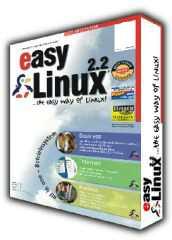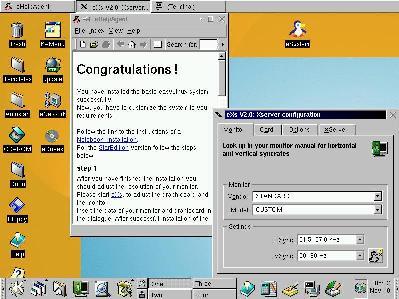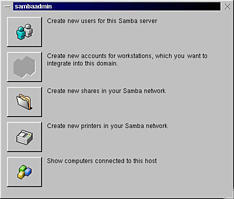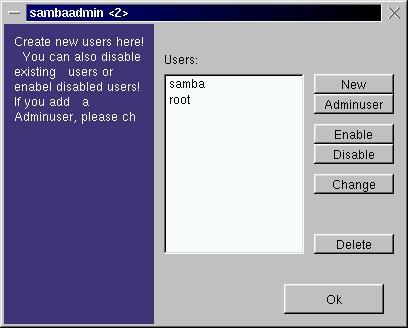

EasyLinux and easySamba, developed by easy Information Technology and resold by IGEL@USA are intended to be an easy introduction to Linux.

Manufacturer: Easy Information Technology
E-mail: info@eit.de, info@igelusa.com
Price: easyLinux v2.2 $29.95 US (full version [reviewed here, 2 CDs]) or $49.95 US (deluxe version [not reviewed here, 5 CDs])
Price: easySamba v1.0 $49.95
Reviewer: Joseph Cheek
EasyLinux and easySamba, developed by easy Information Technology and resold by IGEL@USA (http://www.igelusa.com/), are intended to be an easy introduction to Linux.
The package I received had a boxed version of easySamba and two CDR's of easyLinux, presumably the free-download version. It also included product brochures on IGEL's Linux software products (easyLinux and easySamba), hardware products (Linux thin clients) and consulting and reseller programs.
The easyLinux setup program is graphical with 11 steps required to install the software. After choosing my language, keyboard and mouse type, I was asked for my experience level with Linux: am I a novice, an experienced user or a Linux professional? The choice determined which configurations it would let me choose on the next screen. The professional choice provides the greatest flexibility, allowing my system to be a stand alone PC, an Internet-connected PC, a LAN client or a server.
At this point I could also choose whether I was installing on a laptop (it wouldn't let me select a laptop installation if I wanted a server) and how I wanted my GUI to appear—like Windows, like traditional UNIX (Motif), like newer UNIX (CDE) or like a Macintosh (Platinum). I chose Windows but noticed that I got a KDE 1 interface no matter which choice I made—only the widgets were changed.
On to partitioning: this step is always a difficult one for new users to grasp. The screen showed me all existing partitions on both of my hard drives and allowed me to choose which ones to use for easyLinux, along with whether to format them and where to mount them. Also shown were the existing NFS mounts I had in my /etc/fstab directory from my previous installation. These mounts were carried over into my new installation, a nice touch.
Had I wanted to create new partitions, it gave me options to run both its graphical fdisk tool or plain vanilla text-based fdisk. It didn't allow me to install into an existing Windows partition (as do Red Hat's, Slackware's and others partitionless installs) so I chose an existing ext2partition and Linux swap partition.
Next I was asked to choose my time zone and set up my Ethernet card. After dutifully entering in this information, the file copy started. During the file copy, which lasted about ten minutes, a little penguin strolled around the screen giving advice about easyLinux and telling me what it could do. This was cute.
After the file copy I was asked how to install LILO. I chose to install it in the Master Boot Record of /dev/hda and was told it needed to reboot. Time to see what easyLinux looks like!
When the system rebooted I was presented with a nice KDM login screen. I logged in as root (the setup program told me this was the proper procedure, since no user accounts had been created yet) and was given the opportunity to set a password. An 800x600, 16-bit KDE desktop greeted me with over a dozen icons and a help screen. “Step 1”, it explained, “Please start eXs to adjust the graphic card and monitor.” Beyond this was information instructing me to configure Ethernet cards and load software (didn't I just do these during the install?), add a normal user account, configure additional hardware and create a rescue disk. Hmm, seven additional steps, two of which are redundant, and then I will have a functioning easyLinux system.

Figure 1. After successfully loading easyLinux, I was greeted with this desktop and told to run eXs, the X configuration program. Here is the on-line help with eXs showing. The desktop is KDE 1.1.2
eXs couldn't get my display to run at 1024x768x32, nor could it get 800x600 for my Trident 3dimage985 video card nor my CTX PR700 monitor (although both were listed in the configuration program). I'm not sure whether this was because it wanted to guess refresh rates (it wouldn't let me choose any beyond BEST or SAFEST) or because it was using XFree86 3.3.5, but I elected to stay with the working frame buffer X server to which it defaulted.
A quick perusal of eEtherPro, the included Ethernet configuration program, showed my install settings were intact, but no driver was installed for my 3C905B network card. eAdapterDetect to the rescue! It found the card and installed the driver right off the bat. Now eEtherPro had the adapter and could start the network drivers.
The third step, install software, is really necessary because the only standard application software I found loaded were two text editors and two MPEG video players. eProfile, the application loader, gave me a list of hundreds of applications that I could load from the included CD set. Without a “select all” option, I saw I would have to check each of the hundreds of applications manually to get a full system. I instead checked only a few games, Netscape and sound and video support, and waited for it to install the 78 packages it calculated I would need (from dependencies and such). After logging out and logging back in, the new programs showed up in the menu.
It should be mentioned here that each time the easyLinux CD is needed, a dialog pops up on the screen stating “Please insert easyLinux CD 1 (or 2).” The CD automounts, using the BSD automounter, amd. It works rather well, except that eXs asked for the CD six times before it recognized I already had it in the drive. I ended up ejecting it and reinserting it, and it mounted fine. Sure beats mount -t iso9660 /dev/cdrom /mnt/cdrom and umount /dev/cdrom; eject.
Adding a user, with kuser, was a simple task. Enter full name, user id, home directory, password twice and voilà! Configuring a printer brought up Netscape (which I luckily had just installed via eProfile) but instead of getting a printer control panel, I got Netscape search results for “localhost631”. The CUPS administration service wasn't started; a quick /etc/rc.d/init.d/cups start later, and I was back in business.
Well, sort of. The easyLinux help link to adding a printer wasn't working, but as I figured it out manually I realized my Canon BJC 4400 wasn't supported. The printing software was CUPS, and being familiar with LPRng myself I didn't have the expertise to work around it. Oh well.
Step six, hardware setup with eHardware, let me install a sound driver (OSS found my Sound Blaster 16, ALSA didn't). The OSS autoprobe worked well. It would have allowed me to set up a joystick, a TV tuner card and ISA PNP devices had I had any on this system (I didn't).
I chose to skip the last step, create a rescue disk, because I wanted to get to know my new system better. Under the hood, I saw that this was an RPM-based glibc 2.1.3 system with KDE 1.1.2, XFree86 3.3.5 and gcc 2.95.2. Kernel 2.2.16, Netscape 4.74, CUPS 1.1b5 and ALSA 0.5.8 were included. The server install, with the games and multimedia utilities I installed, used 656MB on my hard drive. The system didn't appear to be based on Red Hat or derivatives, Caldera or SuSE, or at least it was disguised enough that I couldn't tell.
The desktop, once I got playing around with it, seemed no different than any other KDE 1.1.2 desktop. No tuning was done to the desktop itself, other than to add a background image with their logo and a few desktop icons. The biggest value adds I saw with easyLinux were the configuration tools.
Beyond the installer and the configuration tools already described, easyLinux bundles a disk wizard (mount new partitions), an FTP setup wizard, an inetd wizard (start and stop inetd services), an ISDN gateway wizard, a printer wizard (which would allow me to install LPRng, but I couldn't get it to work), a RAID wizard (build a RAID 1 mirror or Linear mode partition), a graphical logfile viewer, a graphical kernel building utility, a registry editor and a list of active services.
All in all, almost two dozen wizards or graphical configuration utilities were included, all integrated with the KDE desktop or configuration manager.
In my mind the question, “If I were a new user, would I want to use easyLinux?” lingered. The second question, “If I were a new user, would I find value in the administration utilities easyLinux has bundled?” I could answer affirmatively. But the larger question: “Would I use this distro?”—I'm not sure I would. Here's why:
There are a lot of bugs. Some are minor annoyances (such as the numerous spelling errors), some are pesky, but not insurmountable (such as the X server not letting me work at 1024x768) and some are pretty bad (easyLinux wouldn't install at all on my laptop, giving me L 80 80 80 80 80 errors when I booted with the CD). Instead of listing all of them here, I'll just say I found dozens in the several hours I played with easyLinux. For version 2.2 of their software, I had expected better.
The dialogs in the graphical configuration tools are nice but not intuitive. The colors weren't consistent, the buttons weren't placed in the same location, the help icons were scattered all over the dialogs and so on. Some didn't work at all or needed a lot of tweaking to get working. It got very confusing.
The on-line documentation has pretty good coverage of the different topics but not much depth. Some of the help files had links to files that didn't exist, but generally the help was hard to follow.
This distribution has a great concept, but in order to execute well it could use some more polish. My advice to eIT: stop kitchen-sinking. Remove some of the functionality of your distribution and spend more time making what you leave in work very well for the market you target. Having a single version of a distro work for an Internet desktop, a stand-alone PC, a LAN client and a network server, with customized GUI clients for each little bit of configuration, is an enormous amount of work. Find out which markets you wish to target and focus your distribution a little more on those.
Now to try easySamba. easySamba comes on one CD with a 70-page user manual. Twenty pages of the user manual describe how to set up and configure easySamba, while the other 50 describe Samba, the SMB protocol behind Samba and Windows networking and list security issues with Samba and Windows 95 and Windows for Workgroups (along with how to fix them).
easySamba claims it runs on easyLinux, SuSE, Red Hat and compatible systems. I tried to load it on Redmond Linux, based on Caldera, and even though it detected my system as being Caldera-compatible, it didn't load correctly. I was using kernel 2.4.0-test10, glibc 2.1.95 and Samba 2.0.7, and it overwrote key packages with older versions of the same package. Even after doing so, it would not work correctly.
On my easyLinux system, easySamba installed, well, easily. After inserting the CD into my CD-ROM drive I clicked on the setup script, clicked the forward button and the finish button and was presented with the Samba Wizard.
A few questions were asked: did I want a PDC (Primary Domain Controller), a workstation or a workgroup computer? What did I want for a domain name, and a description for this computer? Did I want to use WINS (the Windows Internet Naming Service)? After entering this and clicking Finish, I was presented with a screen showing the Samba service installed but not active. I activated it and tried to browse from another computer.
Unfortunately, the other computer was the one that easySamba had failed to load on. Perhaps this was the reason I could not see the easySamba server from this computer. I could see it from itself using the smbclient -L command, so I was fairly sure the easySamba installation worked well.
At least, as a PDC it worked well. As a workstation it wanted to know the name of the PDC and a Samba PDC wouldn't work. It had to be a real Windows PDC, I gathered. A workgroup computer installation worked well, but not the workstation installation.
The Samba administration program sambaadmin was added to the KDE menu after a successful installation. This program allows administration of Samba users, workstation accounts (on a PDC), and file and printer shares. It also shows computers connected to that host.

Figure 2. easySamba's GUI configuration tool, samba admin, lets you administer samba user and workstation accounts and file and printer shares, as well as seeing which computers are attached to your Samba server. The workstation option is grayed out because I chose to do a workgroup computer install, so no workstation accounts were needed.
New file shares are created through kfm, the file manager, similar to the way they are done in Windows. Right click on a directory, choose samba share and a dialog pops up asking for a name, a comment, the path (with a default filled in) and which users are allowed to access it. These new shares are automatically accessible, without requiring a manual restart of the samba service.
I created three file shares this way and attempted to edit them via sambaadmin. For some reason only two of them showed up in the GUI dialog, although smbclient -L showed all three. Strange.
Parsing through the /etc/smb.conf file, I noticed that password encryption and UNIX password synchronization were enabled. No smbpasswd file was defined or populated, which meant that if I had wanted to give my UNIX users Samba access rights I would have to do it by hand. This is not a big deal unless there are many UNIX users to add; I suppose someone in this situation would rather have done this via a script than a GUI anyway.
Security with a network service is always important to me. A guest user, samba, was configured in the smb.conf file but not defined in the smbpasswd file. After creating a samba user I tried to access a share but was denied due to bad name/password pair. I grepped the logs to find the one easySamba used—/var/log/syslog—but couldn't get any clues as to what was wrong. I created a blank password for the samba user. Still no go. I made up a password for this user. Voilà, it worked! Guest accounts therefore must have a password. To me, a guest account is one without a password, but I guess that isn't the way everyone thinks.
I decided to forego heavy-duty security and usability testing. The admin interface is fairly nice, and the bugs are relatively minor. easySamba is a little easier to use than Samba's native GUI configuration tool, SWAT, but the only significant value add I see in easySamba is the ability to add file shares via a right-click in kfm. Still, that feature is pretty cool in my book.

Figure 3. When administering user accounts with easySamba, you can create normal users, administrative users, enable and disable user accounts, delete users and change user passwords.
If I were a small network administrator and wanted to set up a Samba server, would I consider using easySamba? Yes, I would. It generally works as advertised, and it's easy to use and load. Further documentation is missing how to troubleshoot easySamba would be a great addition—Why doesn't the guest account work? Why can't I join an easySamba workstation to an easySamba domain? Why don't all of my shares show up in the configuration tool? How do I check the logs? What should I look for in the logs? Why doesn't the send message button work when I am connected from my own computer? and so on.
And, of course, it should prompt the user before overwriting newer packages with older versions.